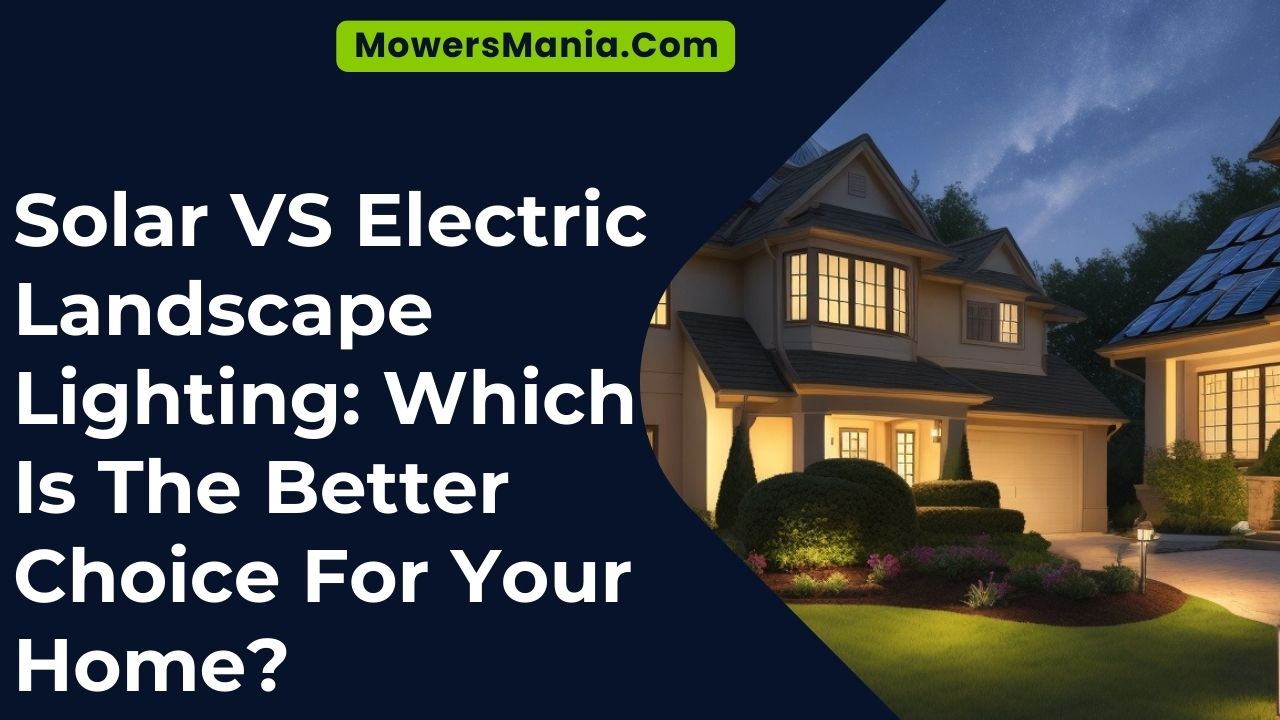Are you considering landscape lighting for your home, but not sure whether to go solar or electric?
Look no further! In this article, we’ll break down the pros and cons of solar and electric landscape lighting.

Discover which option is more cost-effective, easier to install, and more energy-efficient. We’ll also explore the durability, maintenance, and environmental impact of both choices.
By the end, you’ll have a clear understanding of which lighting option is the better choice for your home.
Cost-Effectiveness
When it comes to cost-effectiveness, solar landscape lighting offers significant savings compared to electric alternatives. By harnessing the power of the sun, solar lights eliminate the need for electricity, reducing your monthly energy bills.
Unlike electric landscape lighting, which requires wiring and installation by a professional, solar lights are easy to install yourself, saving you money on labor costs. Additionally, solar lights have minimal maintenance requirements, further reducing your expenses over time.
With solar landscape lighting, there are no ongoing electricity costs, as the lights are powered by sunlight. This means that once you make the initial investment in solar lights, you can enjoy the benefits of outdoor lighting without worrying about increasing energy bills.
On the other hand, electric landscape lighting requires a constant supply of electricity, which can add up over time.
Furthermore, solar lights are a long-term investment that can provide savings for years to come. With advancements in solar technology, the efficiency and lifespan of solar lights have significantly improved.
Many solar lights now come with built-in rechargeable batteries that can store energy efficiently, ensuring that the lights stay illuminated even during cloudy days or nights.
Ease of Installation
To install solar landscape lighting, you simply need to follow a few easy steps.
First, choose the location for your lights and ensure that it receives enough direct sunlight during the day. This is crucial as the solar panels need sunlight to charge the batteries that power the lights at night.
Next, assemble the lights by attaching the solar panels to the fixtures and inserting the batteries.
Finally, place the lights in the ground or mount them on a wall using the provided stakes or brackets. It’s as simple as that!
Installing electric landscape lighting, on the other hand, requires a bit more effort.
Here are three reasons why solar landscape lighting is easier to install:
- No wiring needed: Unlike electric landscape lighting, solar lights don’t require any complicated wiring. This means you can easily install them yourself without the need for an electrician.
- No need for an electrical power source: Solar lights are powered by the sun, so you don’t need to worry about finding a nearby electrical outlet or extending your existing electrical system.
- Flexibility in placement: Solar lights can be placed anywhere in your yard as long as they receive enough sunlight. This gives you the freedom to experiment with different lighting designs and easily relocate the lights if desired.
With the simplicity and convenience of solar landscape lighting, it’s no wonder that many homeowners are opting for this easy-to-install option.
Energy Efficiency

Now let’s delve into the energy efficiency aspect of solar and electric landscape lighting, and see how they compare.
When it comes to energy efficiency, solar landscape lighting takes the lead. Solar lights derive their power from the sun, converting sunlight into electricity through photovoltaic cells.
This means that they don’t rely on the electrical grid and don’t consume any electricity. As a result, solar lights have zero operating costs and are extremely energy-efficient.
On the other hand, electric landscape lighting relies on electricity from the grid, which means it consumes energy and adds to your electricity bill.
While electric lights have become more energy-efficient over the years, they still require a constant power source to operate. This can lead to higher energy consumption and increased costs in the long run.
Solar lights not only save on energy costs but also have a positive impact on the environment. By harnessing solar power, they reduce greenhouse gas emissions and help combat climate change. They’re a sustainable and eco-friendly choice for your home.
Durability and Maintenance
Moving on to durability and maintenance, let’s now explore how solar and electric landscape lighting compare in terms of longevity and upkeep.
- Longevity:
Solar landscape lighting systems typically have a longer lifespan compared to electric ones. This is because solar lights are designed to withstand outdoor elements such as rain, snow, and extreme temperatures. On the other hand, electric lights may require more frequent replacements due to wear and tear caused by exposure to the elements.
- Maintenance:
Solar landscape lights require minimal maintenance. Once installed, they operate automatically, relying on sunlight to charge their batteries during the day and illuminate the landscape at night. Electric landscape lights, on the other hand, may require more maintenance. You may need to regularly check the wiring, replace bulbs, and ensure proper electrical connections.
- Repairability:
Solar landscape lights are generally easier to repair compared to electric lights. If a solar light stops working, it’s often a simple matter of replacing the rechargeable battery or the LED bulb. Electric lights, on the other hand, may require professional assistance to troubleshoot and fix any wiring or electrical issues.
When considering durability and maintenance, solar landscape lighting emerges as the more convenient and long-lasting option.
With minimal upkeep requirements and easier repairability, solar lights can provide reliable illumination for your landscape without the hassle of frequent replacements or complex maintenance procedures.
Environmental Impact

Consider the environmental impact of your lighting choice when deciding between solar and electric landscape lighting. Both options have different effects on the environment, so it’s important to weigh the pros and cons.
| Solar Landscape Lighting | Electric Landscape Lighting |
|---|---|
| Uses renewable energy source | Relies on electricity from the grid |
| Zero carbon emissions | Contributes to carbon emissions |
| Requires no additional wiring or infrastructure | Requires wiring and infrastructure |
| Utilizes natural sunlight to charge the batteries | Draws power from the grid, which may be generated from non-renewable sources |
| Low maintenance and operating costs | Higher maintenance and operating costs |
| May have limited performance on cloudy days | Consistent performance regardless of weather conditions |
Solar landscape lighting is an eco-friendly option as it relies on renewable energy and produces zero carbon emissions. It also requires minimal maintenance and has lower operating costs. However, its performance may be affected on cloudy days.
On the other hand, electric landscape lighting contributes to carbon emissions and relies on electricity from the grid. It requires more maintenance and has higher operating costs. Nevertheless, it provides consistent performance regardless of weather conditions.
When considering the environmental impact, solar landscape lighting emerges as the more sustainable choice.
It not only reduces your carbon footprint but also lowers your energy costs in the long run. By making an environmentally conscious decision, you can create a beautiful landscape while minimizing your impact on the planet.
Frequently Asked Questions [FAQs]
What Are the Main Differences in Cost Between Solar and Electric Landscape Lighting Options?
The main differences in cost between solar and electric landscape lighting options depend on factors such as installation, maintenance, and energy consumption. You’ll need to consider upfront costs and long-term savings to determine which is the better choice for your home.
Can Solar Landscape Lighting Be Installed in Areas With Limited Sunlight Exposure?
Yes, solar landscape lighting can be installed in areas with limited sunlight exposure, but it may not perform as well as in sunnier areas. Consider electric landscape lighting as an alternative option for better performance.
How Do Solar Landscape Lights Compare in Terms of Brightness and Quality of Light?
Solar landscape lights provide adequate brightness and quality of light for most outdoor spaces. They are a convenient and energy-efficient option, ideal for areas with limited sunlight exposure.
Are There Any Specific Maintenance Requirements for Electric Landscape Lighting?
There are specific maintenance requirements for electric landscape lighting. You need to regularly check and replace bulbs, clean fixtures, and inspect wiring to ensure proper functionality and safety.
What Is the Overall Lifespan of Solar Landscape Lighting Compared to Electric Alternatives?
Solar landscape lighting typically has a shorter overall lifespan compared to electric alternatives. However, it can still provide several years of reliable service if properly maintained.
Conclusion
In conclusion, when deciding between solar and electric landscape lighting for your home, consider your priorities.
Solar lighting may be a more cost-effective and environmentally friendly option, but electric lighting offers ease of installation and potentially greater durability.
Both options have their advantages, so choose the one that best suits your needs and preferences.



